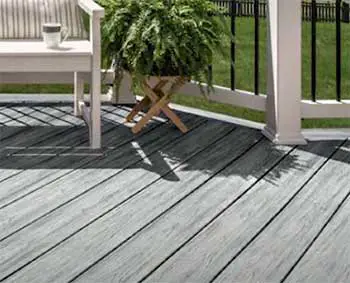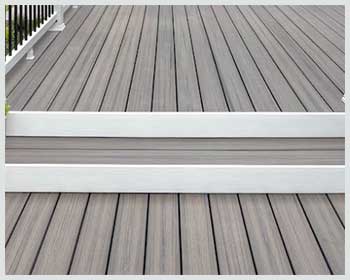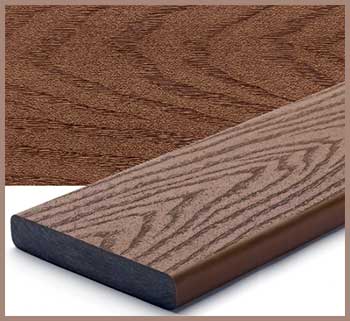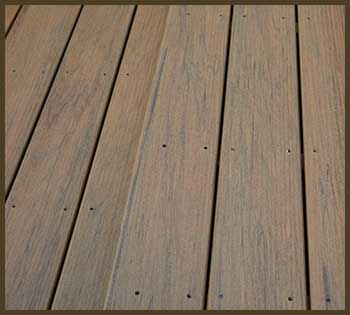As a homeowner, I’ve spent countless hours dreaming up the perfect outdoor space—a deck where I can sip coffee in the morning or host summer barbecues. When I decided to upgrade my backyard with Trex composite decking, I faced a choice: grooved or square boards?
Both promise durability and low maintenance, but each brings unique vibes and practicalities. In this article, I’ll walk you through my journey of comparing Trex grooved and square decking, breaking down their pros and cons, key features, and installation quirks to help you make the best choice for your outdoor oasis.
A Brief Comparison Table
| Feature | Grooved Decking | Square Decking |
| Installation Method | Hidden fasteners (clips) for a seamless look | Traditional deck screws, visible unless plugged |
| Aesthetic | Sleek, modern, fastener-free surface | Classic, wood-like with visible screws or plugs |
| Cost | Higher due to fastener system | More budget-friendly, uses standard screws |
| DIY Friendliness | Moderate; requires precision for clips | Easier; straightforward screw-down method |
| Durability | Same as square; depends on Trex line | Same as grooved; depends on Trex line |
| Maintenance | Easy, but grooves may trap debris | Easy, smoother surface simplifies cleaning |
| Best Use | Main deck areas, polished look | Edges, stairs, picture framing |
| Safety | Smooth, barefoot-friendly | Smooth, but screws may pose minor risks |
| Heat Retention | Varies by color; Lineage offers cooling tech | Varies by color; Lineage offers cooling tech |
Understanding Trex Decking: My Starting Point

When I began researching Trex decking, I was drawn to its reputation for durability and eco-friendliness.
Made from 95% recycled materials, Trex boards resist rot, termites, and warping—unlike the old wooden deck I replaced, which splintered and faded faster than my patience.
Trex offers three main lines: Enhance (entry-level), Select (mid-tier), and Transcend (premium), with the Transcend Lineage boasting heat-mitigating technology.
Both grooved and square boards are available across these lines, but their differences lie in installation, aesthetics, and practical use.
I wanted a deck that looked sharp, felt safe underfoot, and didn’t break the bank, so I dug into the details.
What Are Grooved Trex Boards?

Grooved Trex boards have notches along their edges, designed for hidden fastener systems like Trex’s Universal Fasteners or Hideaway clips.
These clips snap into the grooves and screw into the joists below, leaving no visible screws on the deck surface.
The first time I saw a grooved deck, I was struck by its clean, polished look—like a floor you’d expect in a high-end backyard resort.
The grooves are subtle, not affecting the top surface, which mimics wood grain with textures like those in Enhance Naturals or Transcend’s tropical hues.
The installation process, though, gave me pause. You build the deck frame (joists spaced at 16 inches for most Trex lines), snap clips into the grooves, and secure them with screws. The next board slides over the clips, and you repeat.
It’s methodical but requires precision to avoid wobbly boards. I watched a contractor friend install one, and while it wasn’t rocket science, it felt less forgiving than hammering nails into wood. Still, the result was a smooth, screw-free surface that screamed sophistication.
Pros of Grooved Trex Decking
The biggest draw for me was the aesthetic. A grooved deck looks sleek, with no screw heads disrupting the flow of the wood-grain pattern. This is a game-changer if you’re like me and obsess over clean lines in design.
The hidden fasteners also mean a safer surface—no raised screws to stub your toe on or snag your kid’s bare feet during a summer sprint. I tested a friend’s grooved Transcend deck, and it felt like walking on a cloud, smooth and inviting.
Another plus is ventilation. The grooves allow for slight gaps between boards, which helps with drainage and airflow. Living in a rainy area, I appreciated this feature—water doesn’t pool, reducing the risk of mold or slippery spots.
Trex’s grooved boards are also versatile; you can use them in the main deck area and pair them with square boards for edges or stairs, creating a seamless transition. Plus, the hidden fastener system feels like a professional touch, elevating the overall vibe of the deck.
Cons of Grooved Trex Decking
But it’s not all sunshine and barbecues. The hidden fastener system bumps up the cost. Clips and specialized tools aren’t cheap, and if you’re hiring a pro, labor costs can climb due to the time-intensive process.
I crunched the numbers for my 300-square-foot deck, and grooved boards with fasteners were about 10-15% pricier than square boards with screws. For budget-conscious folks like me, that stung.
Another downside is debris. Those gaps between boards, while great for drainage, can trap leaves, dirt, or pine needles. I noticed this on a neighbor’s grooved deck—cleaning required a leaf blower or a stiff brush to dislodge gunk.
If you live near trees, this could mean extra maintenance. Also, the grooved edges look less polished when exposed, so you’ll need square boards or fascia to “picture frame” the deck, adding to the material list. Lastly, DIYers might find the clip system tricky if they’re not used to precision work.
What Are Square Trex Boards?

Square Trex boards, also called ungrooved or solid-edge, resemble traditional wooden planks with smooth, flat sides.
They’re installed using deck screws driven through the top into the joists below, just like old-school wood decking.
When I visited a local supplier, I ran my hand over a square Select board—it felt sturdy, familiar, like the lumber I’d helped my dad nail down as a kid.
The screws are visible unless you use plugs (more on that later), giving it a classic, slightly rustic look.
Installation is straightforward: build your frame, predrill holes, and screw the boards down. I watched a YouTube tutorial and thought, “I could do this in a weekend.” Square boards come in the same Trex lines—Enhance, Select, and Transcend—with lengths like 12, 16, or 20 feet.
They’re often used for edges, stairs, or picture framing to hide the grooved ends of other boards, but you can build an entire deck with them if you prefer.
Pros of Square Trex Decking
The biggest win for square boards is cost. They use standard deck screws, which are cheaper than hidden fasteners, and installation is faster, saving on labor if you’re hiring out.
For my deck, I estimated square boards would save me $500-$700 over grooved, a chunk I could redirect to lighting or a fancy grill. The simplicity also makes them DIY-friendly. I’m no carpenter, but screwing boards down felt within my wheelhouse, unlike wrestling with clips.
Square boards are also versatile. They’re ideal for deck edges, stairs, or patterns like herringbone, where grooves would be visible or impractical. If you want a traditional wood-deck look, square boards deliver—especially in Transcend’s rich colors like Jasper or Biscayne.
Cleaning is a breeze too; the smoother surface doesn’t trap debris as easily as grooved boards. I hosed down a sample square board, and it looked pristine with minimal effort.
Cons of Square Trex Decking
The downside? Visible screws. Even with color-matched screws, they’re noticeable, and I found myself fixating on them during a backyard tour at a friend’s place. You can use plugs—small caps that cover screw heads—but they add cost and time, and I’ve heard they can pop out over time.
Safety is another concern; raised screws, if not perfectly flush, could catch a toe. My nephew tripped on a loose screw once, and it made me paranoid about my own deck.
Square boards also lack the drainage gaps of grooved boards, so water can pool if your deck isn’t perfectly sloped. In my area, where rain comes in bursts, this could mean more frequent cleaning to prevent mildew.
Finally, if you’re aiming for a modern, seamless look, square boards might feel too traditional, especially in Enhance or Select lines, which have simpler grain patterns compared to Transcend’s premium streaking.
Key Features of Trex Grooved And Square Decking

Both grooved and square boards share Trex’s core strengths: a high-performance shell that resists fading, staining, and scratching, plus warranties ranging from 25 to 50 years depending on the line.
I was impressed by Transcend Lineage’s SunComfortable technology, which reduces heat by up to 35 degrees—crucial for my sunny backyard.
Both types come in vibrant colors, from Enhance Basics’ monotone Clam Shell to Transcend’s multi-tonal Island Mist, letting you match your home’s vibe.
The main difference is installation and aesthetics. Grooved boards prioritize a fastener-free look and better drainage, while square boards offer simplicity and a classic style. Both are eco-friendly, using recycled plastic and sawdust, and neither requires staining or painting—a relief for someone like me who dreads annual deck maintenance.
- Installation: My Hands-On Experience
I decided to try a small test installation with both types to get a feel for the process. For the grooved boards, I used Trex’s Universal Fasteners on a 4×4-foot frame. Aligning the clips was fiddly, and I cursed a few times when a board wouldn’t snap in perfectly.
But once I got the rhythm, the process was satisfying, and the clean surface was worth it. The square boards were a breeze—I predrilled holes, drove screws, and had a section done in half the time. The screws were noticeable, though, and I debated splurging on plugs.
One tip I picked up: always check your joist spacing (16 inches for perpendicular boards, 12 for stairs or angled patterns). I also learned to use joist tape, a game-changer for protecting the frame from rot. Grooved boards felt more “pro,” but square boards were forgiving for my amateur skills.
- Aesthetics: What Vibes Are You Going For?
Your deck’s look depends on your style. I leaned toward grooved boards for their modern, uncluttered surface, especially in Transcend’s Rainier, a silvery gray that felt coastal and chic.
But when I mocked up a square board section with color-matched screws, it had a timeless charm, like a weathered pier. Square boards shine in picture framing or stair risers, where their clean edges hide the grooved ends of other boards.
I mixed both on my test deck—grooved for the main area, square for the border—and it looked sharp, like a custom job.
- Cost Breakdown: Budgeting for Your Deck
Cost was a big factor for me. For a 300-square-foot deck, Trex’s material cost (excluding substructure) ranges from $15-$30 per square foot, so I was looking at $4,500-$9,000 total.
Grooved boards pushed me toward the higher end due to fasteners, while square boards stayed closer to $15-$20 per square foot. Labor costs vary, but grooved installations can add $2-$4 per square foot for pros. I got quotes from local contractors, and one suggested square boards for DIY to save cash, which was tempting.
- Durability and Maintenance: Long-Term Thoughts
Both grooved and square boards are built to last, with Trex’s fade- and stain-resistant shell. I spilled red wine on a sample board (oops) and cleaned it with soap and water—no stain, no drama. Durability depends more on the Trex line than the board type.
Transcend’s thicker cap resists scratches better than Enhance, which I noticed when my dog clawed at a sample. Maintenance is simple for both: sweep regularly, hose down occasionally, and use mild soap for tough spots.
Grooved boards need extra attention to clear debris from gaps, but it’s not a dealbreaker.
- Safety and Comfort: Walking the Deck
I’m big on safety, especially with kids and pets around. Grooved boards felt safer—no screws to trip over, and the gaps reduce slipperiness in rain. Square boards are fine if screws are flush, but I’d avoid them in high-traffic areas unless you’re diligent about maintenance.
Both get hot in direct sun (darker colors like Jasper are toasty), but Transcend Lineage’s cooling tech makes a noticeable difference. I walked barefoot on a Lineage sample on a 90-degree day, and it was bearably warm compared to my old wood deck.
- Mixing and Matching: A Hybrid Approach
One revelation was that I didn’t have to choose one or the other. Many pros use grooved boards for the main deck and square boards for edges, stairs, or accents. This “picture framing” technique hides grooved ends and adds a polished border.
I sketched a design with grooved Enhance Naturals in Rocky Harbor for the field and square Select in Universal White for the frame—it looked cohesive and saved me money compared to an all-Transcend setup.
- My Decision-Making Process
Choosing between grooved and square came down to priorities. I wanted a modern look, so grooved boards initially won me over. But the cost and DIY ease of square boards made me reconsider.
I also thought about my lifestyle—frequent rain, kids running around, and my hatred of cleaning. The hybrid approach felt right: grooved for the main area, square for edges. I chose Transcend Lineage for its cooling tech and 50-year warranty, balancing cost with longevity.
Tips For Your Decision
If you’re on the fence, here’s my advice. Walk on sample boards at a supplier to feel the difference. Consider your budget—square boards are cheaper, but grooved boards elevate the look. Think about who uses your deck: kids or pets might benefit from grooved’s smoother surface.
Check your climate—grooved boards drain better in wet areas, while square boards suit drier regions. Finally, play with Trex’s online Deck Designer tool to visualize your setup. It helped me see how colors and patterns would look in my backyard.
Also Read: Differences Between NewTechWood And Trex Composite Decking.
Frequently Asked Questions (FAQ)
Grooved Trex decking has notches on the sides for hidden fasteners, creating a smooth, screw-free surface. Square decking has flat edges and uses visible screws for installation, resembling traditional wood decking.
Choose grooved for a modern, fastener-free look and better drainage, ideal for main deck areas. Use square (flat) for edges, stairs, or budget-friendly projects, as it’s easier to install and cheaper.
Grooved boards are designed for hidden fastener systems, offering a cleaner look without visible screws. They also allow slight gaps for drainage and ventilation, enhancing deck longevity.
The “best” depends on your needs. Transcend Lineage offers premium durability, heat-mitigating tech, and a 50-year warranty. Select balances quality and cost, while Enhance is budget-friendly but less scratch-resistant.
Conclusion: Your Deck, Your Choice
You’re standing at the crossroads of grooved and square Trex decking, and I’ve been there. Grooved boards give you that sleek, modern vibe with a safer, screw-free surface, but they cost more and demand precision.
Square boards save you cash and feel familiar, perfect for DIYers or classic looks, though visible screws might bug you. I went with a mix—grooved for the main deck, square for the edges—and it’s transformed my backyard into a space I love.
Weigh your priorities, test some samples, and build a deck that makes you smile every time you step outside.
